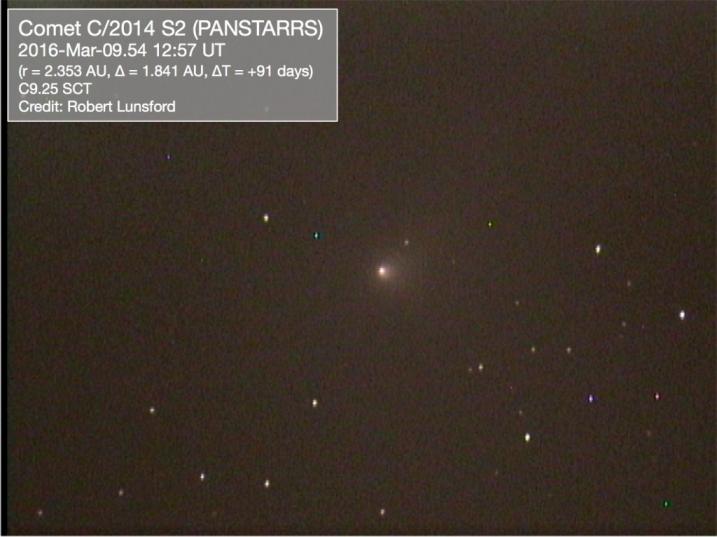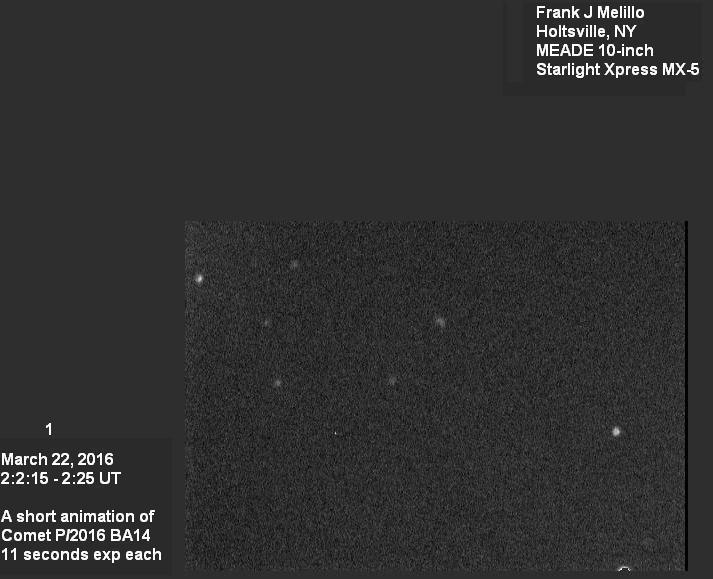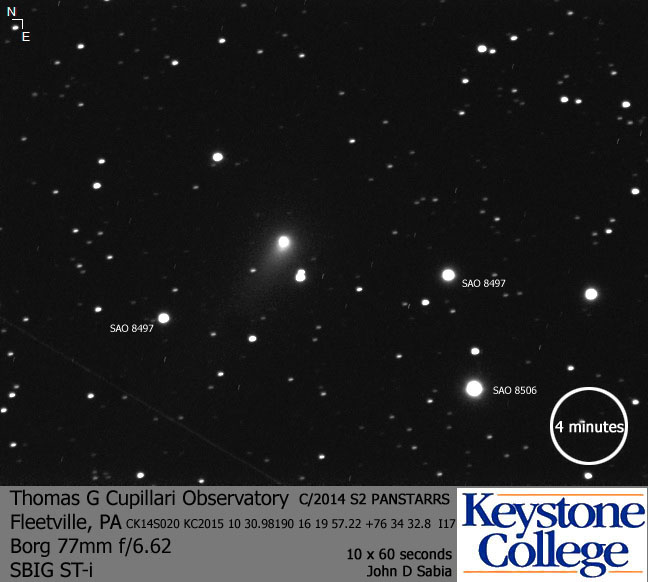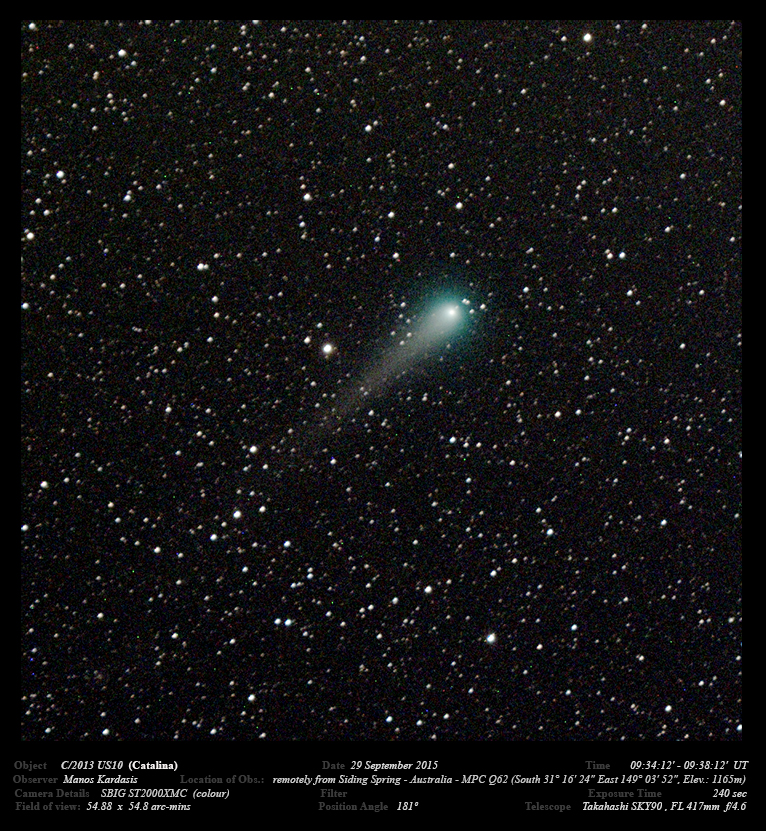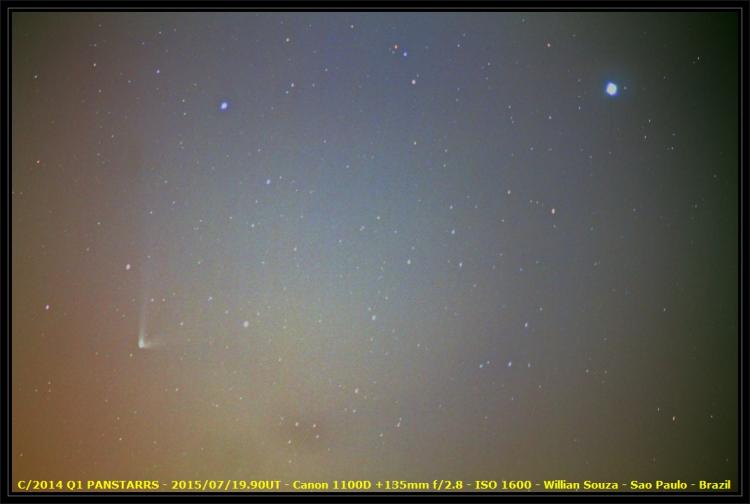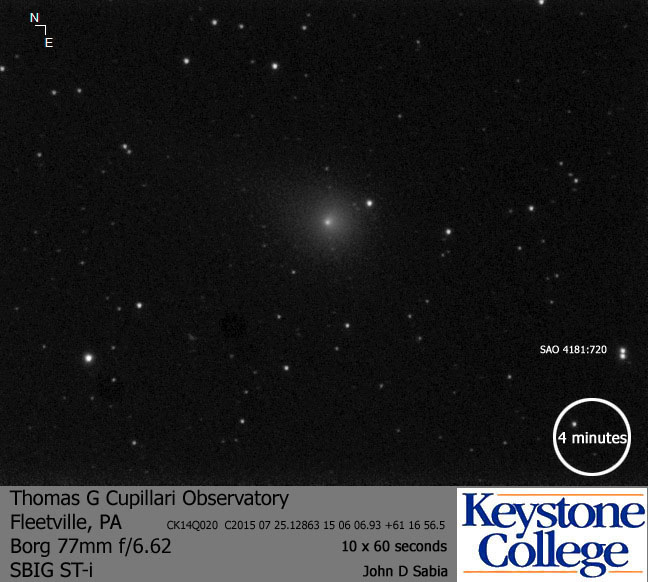ALPO COMET SECTION NEWS – APRIL 2016
2016-April-4
The two brightest (observable) comets in March were both surprises. The continued brightness of C/2014 S2 (PANSTARRS) may not be a surprise anymore, but I know I’m always happy to see this comet month after month considering it was not expected to get very bright. Then there’s the case of 252P/LINEAR. Making one of the closest approaches to Earth of the modern era, it was expected to be an exciting CCD target. While that was still true, the comet brightened more than expected and was even a naked eye object for a lucky few.
Evening Comets
C/2014 S2 (PANSTARRS) [Perihelion on 2015-Dec-09 at 2.10 AU from the Sun]
As mentioned above, C/2014 S2 has outperformed expectations. It has held steady near its peak brightness of magnitude 9.0 to 9.5 since November. I was able to easily observe it in 30×125 binoculars at magnitude 9.4 last night (April 3 UT). The comet will be easy to find this month as it slowly crosses the bowl of the Big Dipper from north to south. Its location also makes it a circumpolar object for most northern hemisphere observers. The comet starts the month 2.48 AU from the Sun and 1.95 AU from Earth and ends the month at distances of 2.67 and 2.30 AU from the Sun and Earth. If its current brightness behavior holds, the comet will start to fade this month from between ~9.4 to ~9.7.
The image below from Bob Lunsford gives a good indication of the appearance of C/2014 S2 in small telescopes.
C/2013 US10 (Catalina) [Perihelion on 2015-Nov-15 at 0.82 AU from the Sun]
Comet Catalina is rapidly moving away from the Sun and Earth and is no longer an easy object for small telescopes. In fact, the Comet Section has not received a positive report for this comet since the end of February. I tried to observe it a few times in March with 30×125s and was not successful. Observations submitted to the COBS (Comet Observation Database) site show the comet to still be between 10th and 11th magnitude. Located in Perseus, not too far from the star Capella, US10 is still a good target for large aperture visual observers and CCD imagers. This month it continues to move away from the Sun (2.38 to 2.75 AU) and Earth (2.63 to 3.41 AU).
Morning Comets
252P/LINEAR [Perihelion 2016-Mar-15 at 1.00 AU]
Comet 252P/LINEAR was not forecast to get brighter than ~10th magnitude even though it was making the 6th closest observed comet approach to Earth. Observers down south (close approach occurred at very far south declinations) reported numerous naked eye observations to the COBS site for a few days leading up to its March 21 flyby at 0.036 AU. The brightest estimates put the comet at magnitude 3.8. More naked eye sightings would have been possible if not for a near Full Moon washing out the view.
Luis Mansilla and Willian Souza both reside in the southern hemisphere observers and contributed observations of 252P to the Comet Section. Northern observers started looking for the comet as it rapidly cleared the southern horizon starting on March 24 though the first positive northern Section observation didn’t occur till the 26th due to the bright Moon. The comet was a barely visible ghost with the bright Moon interfering. Now that the comet can be observed in a Moon-less sky, it is large (~1/2 deg) and easily seen in 10×50s. Reports from Salvador Aguirre and Carl Hergenrother have placed the comet between magnitude 5.5 and 6.5 over the past week.
252P should fade this month as it moves away from the Sun (1.02 to 1.19 AU) and Earth (0.07 to 0.24 AU). The rate of its fading is uncertain as the comet does not seem to be intrinsically fading even though it is past perihelion. The comet is easily observable in the morning sky from both hemispheres as it moves northward through Serpens (1-2) and Ophiuchus (2-30).
If you are wondering about 252P’s possible sibling, P/2016 BA14 (PANSTARRS) passed even closer to Earth but never showed much activity other than a short dust tail. Even at its brightest it was relatively faint at magnitude 12.5-13.0. The close approach did allow NASA JPL’s Goldstone radar to image the roughly 1 km in diameter nucleus of BA14 as seen below.
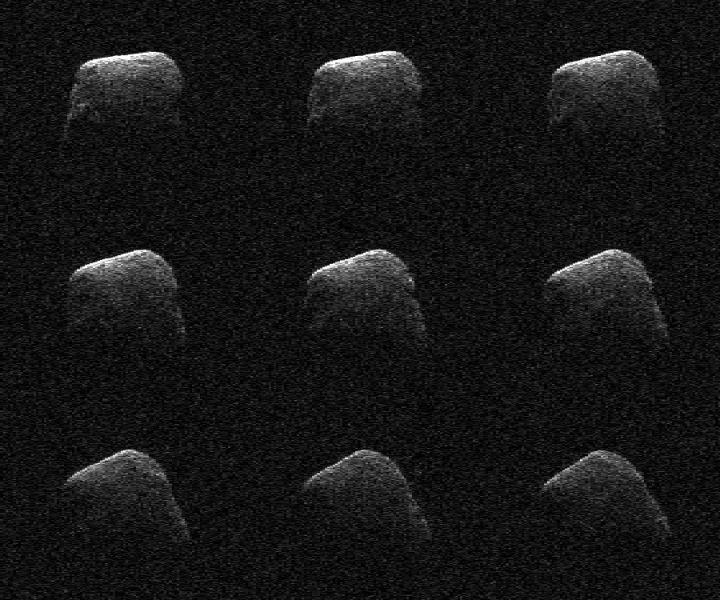
These radar images of comet P/2016 BA14 were taken on March 22, 2016, by scientists using an antenna of NASA's Deep Space Network at Goldstone, California. At the time, the comet was about 2.2 million miles (3.6 million kilometers) from Earth. Credits: NASA/JPL-Caltech/GSSR.
C/2013 X1 (PANSTARRS) [Perihelion on 2016-Apr-20 at 1.31 AU]
C/2013 X1 (PANSTARRS) has been too close to the Sun to be observed from Earth since February. This will change in April as PANSTARRS slowly moves away from the glare of the Sun in the morning sky. On April 1st, X1 is located at a small elongation of 17°. Elongation grows to 30° by April 14, 40° by April 23 and 49° by May 1. The comet spends all of April in Pisces as it moves from 1.35 AU from the Sun on the 1st, passes through perihelion at 1.31 AU on the 20th and only recedes to a heliocentric distance of 1.32 AU at April’s end. Its geocentric distance rapidly decreases from 2.27 AU to 1.74 AU over the course of the month. This distance will continue to drop to a minimum of 0.64 AU in late June. Since it hasn’t been seen in nearly two months, its brightness in April is uncertain but should be between 7th and 8th magnitude.
New Discoveries
Since the last Comet Section News posting, only three comet discoveries were reported.
C/2016 E2 (Kowalski) was found on March 15 with the 0.68-m Catalina Schmidt by Rich Kowalski. The comet is a long-period comet that assed perihelion February 6 UT at 1.08 AU. It passed within 0.30 AU of Earth two days after discovery. The comet is intrinsically faint and only got as bright as 17th magnitude.
C/2016 E1 (PANSTARRS) is a high perihelion distance object (8.0 AU) that doesn’t pass perihelion till August of 2017. It was found by Pan-STARRS on March 3 at 20th magnitude. The large perihelion distance will keep it from getting much brighter.
C/2015 B4 (Lemmon-PANSTARRS) was seen by the Pan-STARRS project as a comet in images taken on 2016 March 13. The Minor Planet Center’s Gareth Williams than identified many other observations of the comet taken over the past year or more with the first on 2015 January 16 by the Mount Lemmon Survey. Now named Comet Lemmon-PANSTARRS, C/2015 B4 is on a 25 year orbit and passed perihelion back in February of 2015 at 3.75 AU from the Sun. It never got brighter than ~20th magnitude.
As always, the Comet Section is happy to receive all comet observations, whether images, drawings or magnitude estimates.
- Carl Hergenrother (ALPO Comet Section Coordinator)

